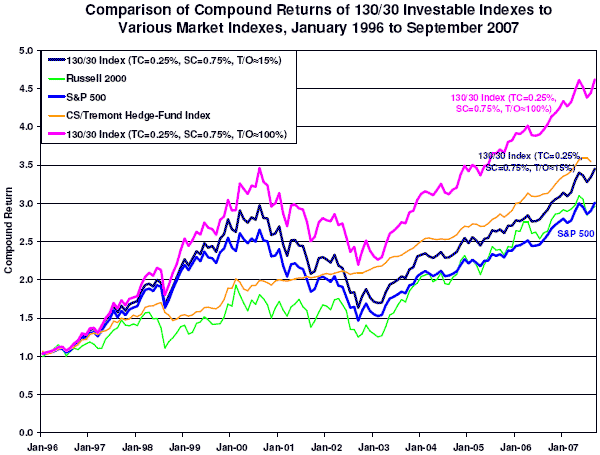Does increasingly powerful and more automated trading technology create the need for more sophisticated equity return benchmarks? In the December 2007 version of their paper entitled “130/30: The New Long-Only”, Andrew Lo and Pankaj Patel present a passive but dynamic “plain-vanilla” 130% long/30% short (130/30) benchmark index based on: (1) simple factors (encompassing value, growth, profitability, momentum and technical) to rank stocks; and, (2) standard methods for constructing a portfolio based on these rankings. Applying a standard portfolio optimizer to 10 well-known and commercially available valuation factors for S&P 500 stocks, with monthly rebalancing during 1/96-9/07, they find that:
- Technological innovations such as automated trading platforms, electronic communications networks, computerized back-office/accounting systems and straight-through processing have changed the meaning of passive investing.
- The essential criteria for a benchmark index ought to be:
- Transparent – rules for construction that are systematic, clear and easily implemented.
- Investable – components that are liquid exchange-traded instruments.
- Passive – implementation that is purely mechanical, requiring little or no manual intervention and discretion.
- The average annual return of the 130/30 index is 14.08% with no turnover constraints, and 14.25% (11.76%) with annualized turnover constraints of 100% (15%). The 130/30 index with 15% turnover constraint outperforms the S&P 500 index in nine of 12 years over the sample period.
- The annual volatility of the 130/30 index is approximately 15%, similar to the 14.68% standard deviation of annual returns for the S&P 500 index. This volatility implies a Sharpe ratio of 0.44 for the 130/30 index (with 15% annualized turnover constraint and a 5% risk-free rate), somewhat higher than the 0.37 Sharpe ratio for the S&P 500 index.
- The 130/30 exhibits high correlation with traditional equity indexes. (See the chart below.)
- While typically much lower, there are years when the S&P 500 index turnover approaches that of the 130/30 index. Turnovers for some other traditional S&P indexes exceed that of the 130/30 index, indicating that the 130/30 index is feasible.
- On average, the 130/30 index with 15% annualized turnover constraint is long 270 names and short 150 names, resembling a typical U.S. large-cap core enhanced-index strategy but with more variable weights.
The following chart, taken from the paper, depicts cumulative returns for the 130/30 index (with 0.25% one-way transaction costs, 0.75% annual short-sales costs, and 15% and 100% annualized turnover constraints) and other popular indexes such as the S&P 500 index, the Russell 2000 index and the Credit Suisse/Tremont Hedge Fund Index. It shows that the 130/30 index behaves much more like a performance-enhanced equity index than the hedge fund index.

In summary, “expect more dynamic strategies [such as 130% long/30% short] to become passive benchmarks as the investor base becomes more sophisticated and demanding.”